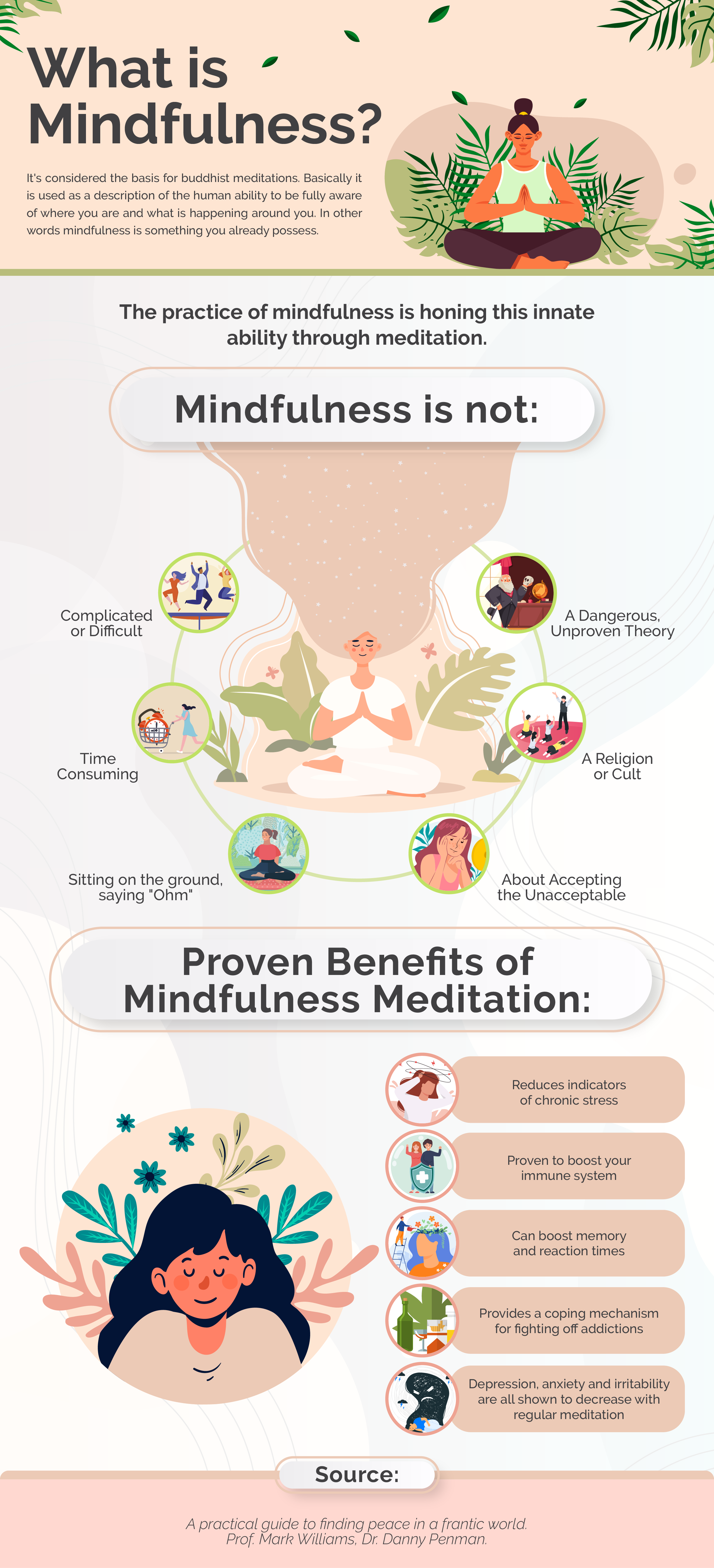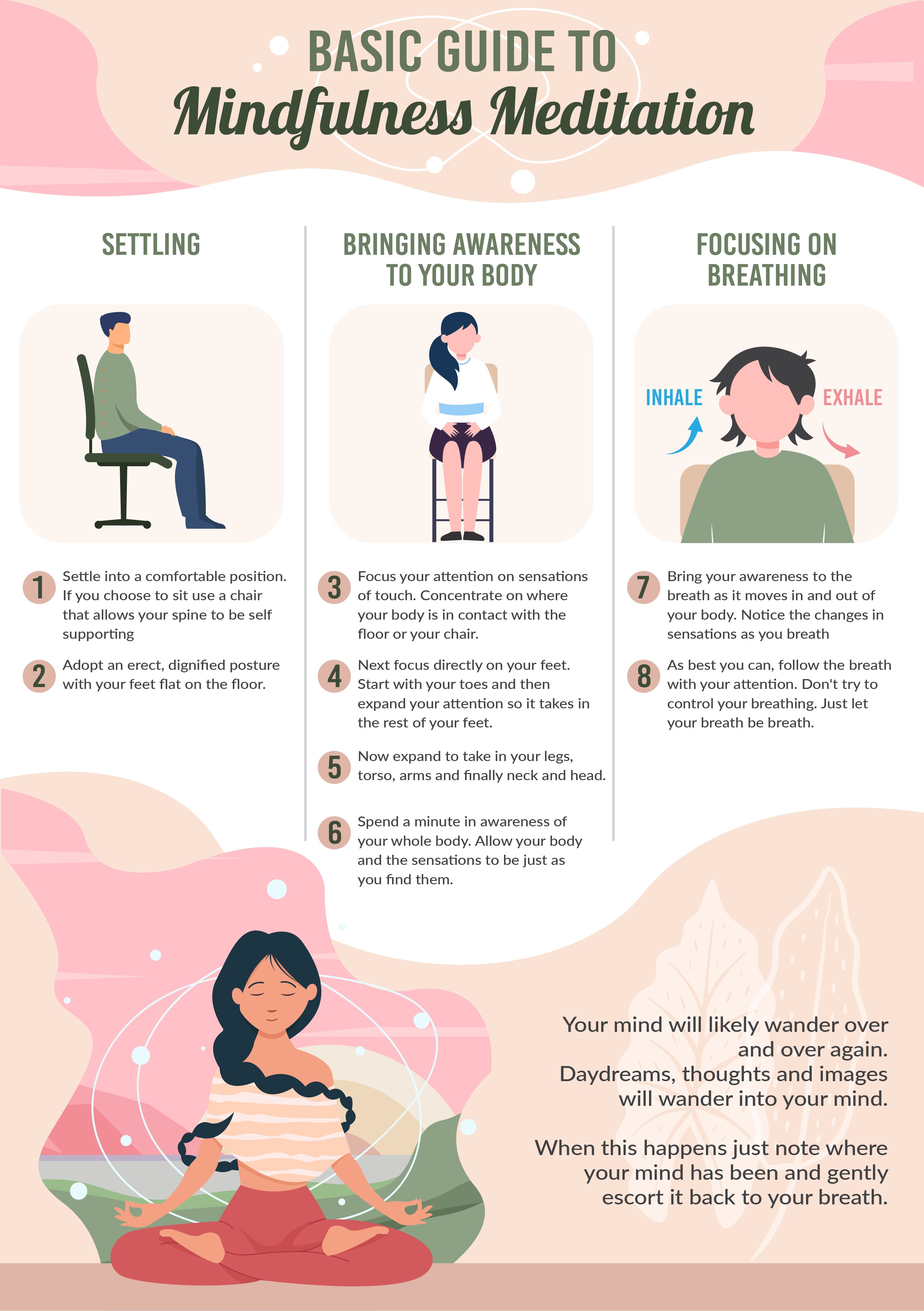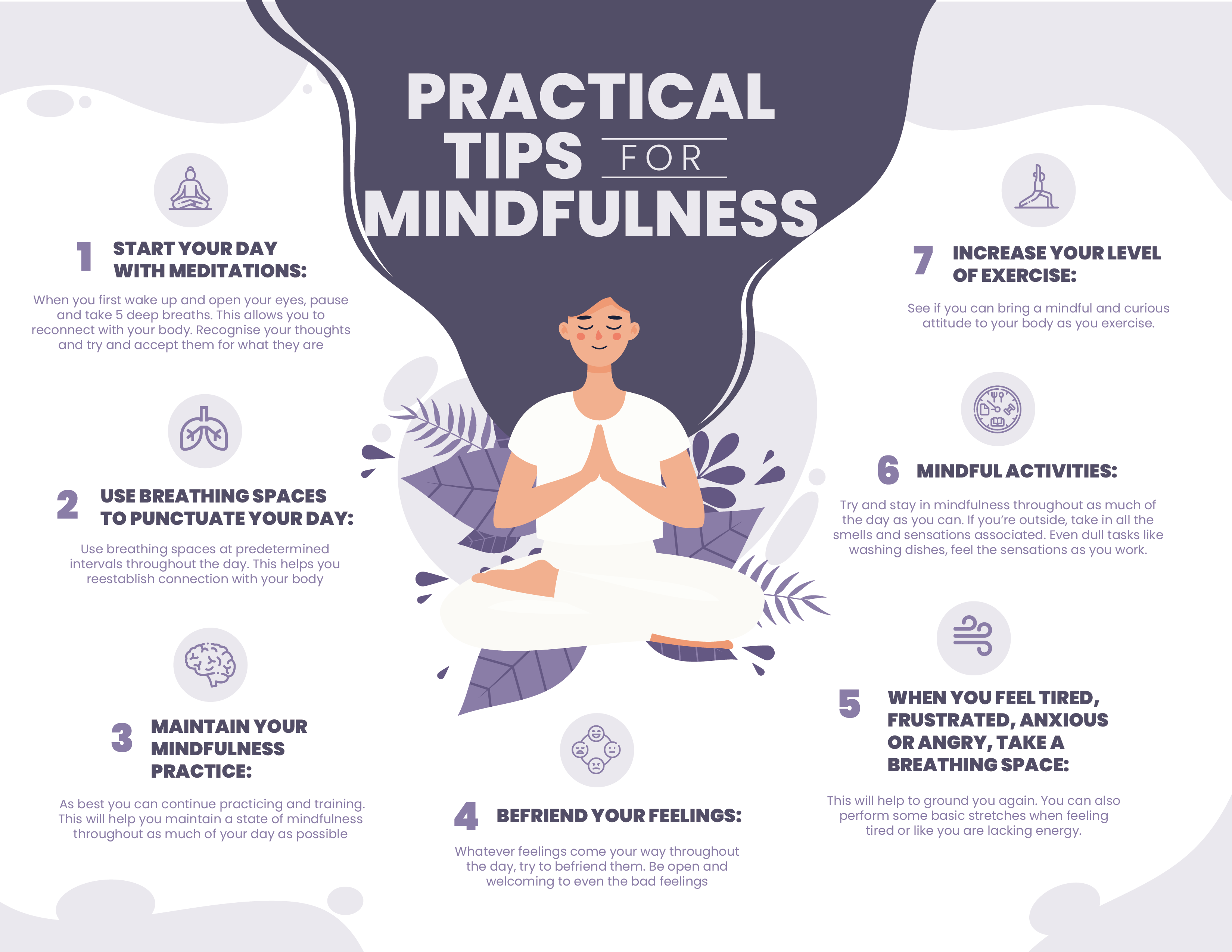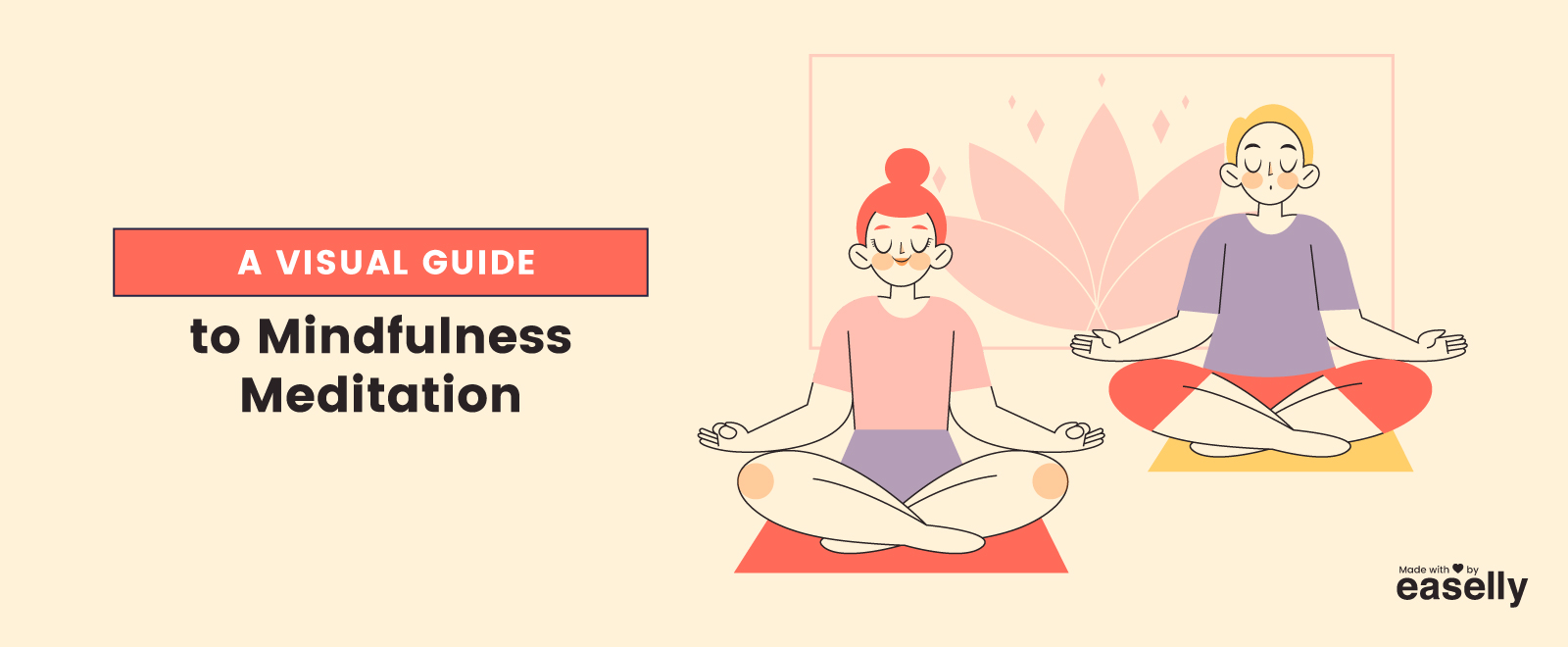Unless you’ve been living under a rock for the past decade or two you’ll have heard the term mindfulness thrown about. However although the term is very popular and widely known, it isn’t all that well understood. Mindfulness practice and meditation has been around for millenia. It has countless devotees from Oprah Winfrey to the late, great Kobe Bryant. Psychological and clinical studies suggest that regular meditators are happier and more content than average.
Obviously some more research needs to be done and the practice has its detractors but there are numerous proven benefits. If you’re interested in starting out there are hundreds of resources and places to start. We’ve simplified some of these with infographics and included an infographic guide to some basic guides and practical applications on your mindfulness journey! Read on for more info!

What is Mindfulness? Common Mindfulness Myths
As mentioned before, mindfulness isn’t anything particularly new. Basically it is used as a description of the human ability to be fully aware of where you are and what is happening around you. In other words mindfulness is something you already possess. Everybody does. The practice of mindfulness is honing this innate ability through meditation.
Here are some common mindfulness myths that need to be dispelled. Mindfulness isn’t:
- A religion or cult. Both religious people and atheists practice mindfulness. Although it has been described as the base of Buddhist meditation by some, it is at the heart of everything a form of mental training.
- Complicated. Meditation, like most practices, can feel difficult at first. However given practice it does get easier. The core concept is easy to grasp however.
- About sitting on the ground, cross legged saying “ohm.” You can absolutely do this if you want to. It isn’t exactly the norm however. There is no right or wrong place to practice mindfulness. Sit in a chair, go for a walk or even practice on the bus to work!
- A dangerous unproven theory. There have been numerous tests and studies verifying some of the claims made by practitioners to do with the benefits of mindfulness. There are still some ways to go however!
- About accepting the unacceptable. Many fear that mindfulness will deaden their mind and dull their instincts. In other words they fear it will soften them up too much. This is completely false, it’s all about seeing the world with greater clarity.
Why is Mindfulness important?
Many successful athletes, CEOs and philosophers mention mindfulness meditation as part of their daily routine. Now obviously there is much work still to be done in exploring the benefits and applications of mindfulness. However there have been significant proven benefits for your well being and your physical and mental health.
To its many practitioners, mindfulness meditation has been a key to a happier, healthier and less stressful existence. You may not get all the benefits but the risk to reward ratio makes it difficult to ignore! Here are some of the benefits of meditation proven by studies:
- Worldwide Studies suggest that regular meditation reduces indicators of chronic stress
- Meditation has been proven to boost your immune system, meaning it can literally help your body fight off diseases and viruses!
- Meditation can boost memory and reaction times. It can also help increase your physical and mental stamina!
- For some it provides a coping mechanism for fighting off addictions to substances and behaviours.
- Finally, depression, anxiety and irritability are all shown to decrease with regular meditation. In today’s society this is perhaps the most important benefit to take away!

Mindfulness Quotes
It’s all well and good talking about the many virtues and misconceptions surrounding the practice of mindfulness. For something a little more practical here are 5 of the most popular quotes about mindfulness meditation that should whet your appetite. If you’d like to skip straight on to the practical guide however please do so!
- “You can’t stop the waves, but you can learn to surf” – Jon Kabat-Zinn
- “Do every act of your life as though it was the last act of your life” – Marcus Aurelius
- “If you want to conquer the anxiety of life, live in the moment, live in the breath” – Amit Ray
- “Feelings come and go like clouds in a windy sky. Conscious breathing is my anchor.” – Thich Nhat Hanh
- “One does not become enlightened by imagining figures of light, but by making the darkness conscious” – Carl Jung
Simple Mindfulness Meditation. Mindfulness of Breath and Body:
The following is an infographic adaptation of one of the most common base components of any mindfulness training programme. The mindfulness of breath and body meditation from Mark Williams and Danny Penman.

Professor Mark Williams and Dr Danny Penman are two academics who co-developed mindfulness based cognitive therapy. MBCT has been described as as effective as prescription drugs for treating depression and anxiety. The book itself has been described as life changing and is considered a great introduction to mindfulness meditation. The following exercise is a basic, simple meditation you can perform daily for noticeable effects.
For noticeable effects you should perform this twice a day for 8-10 minutes. It will be difficult at first but as with anything you will get better with practice.
Settling
- Settle into a comfortable position. Either lie down or sit, whichever is more comfortable. If you choose to sit be sure and use a straight backed chair that allows your spine to be self supporting
- Adopt an erect, dignified posture with your feet flat on the floor. It’s important to be alert and not asleep. Too comfortable a chair or mattress and you’ll easily find yourself dozing off!
Bringing Awareness to your Body
- Focus your attention on sensations of touch. Concentrate on where your body is in contact with the floor or your chair. Spend a few minutes on these sensations
- Next focus directly on your feet. Start with your toes and then expand your attention so it takes in your soles, heels and tops of your feet. Spend a few moments focussed here.
- Now expand to take in your legs, torso, arms and finally neck and head. Pause for a few moments between body parts
- Spend a minute in awareness of your whole body. Allow your body and the sensations to be just as you find them. Try and let go of the tendency to want things to be a certain way.
Focusing on Breathing
- Bring your awareness to the breath as it moves in and out of your body. Notice the changes in sensations as the breath moves in and out
- You may notice mild stretching sensations of stretching as the abdomen gently rises with each breath.
- As best you can, follow the breath with your attention
- Don’t try to control your breathing. Just let your breath be breath.
Your mind will likely wander over and over again. Day dreams, thoughts and images will wander into your mind. Don’t be hard on yourself. When this happens just note where your mind has been and gently escort it back to your breath.

Mindfulness Tips from the Experts
The same book we’ve adapted into infographic form above discusses the use of mindfulness as a parachute of sorts. A method of maintaining peace in an ever more frantic world. However hectic your daily life gets, mastering mindfulness can help you to stay grounded. Here are some tips from Professor Mark Williams and Dr. Danny Penman:
- Start your day with Meditations: When you first wake up and open your eyes, pause and take 5 deep breaths. This allows you to reconnect with your body. Recognise your thoughts and try and accept them for what they are
- Use Breathing Spaces to punctuate your Day: Use breathing spaces at predetermined intervals throughout the day. This helps you reestablish connection with your body
- Maintain your Mindfulness Practice: As best you can continue practicing and training. This will help you maintain a state of mindfulness throughout as much of your day as possible
- Befriend your Feelings: Whatever feelings come your way throughout the day, try to befriend them. Be open and welcoming to even the bad feelings
- When you feel tired, frustrated, anxious or angry, take a breathing space: This will help to ground you again. You can also perform some basic stretches when feeling tired or like you are lacking energy.
- Mindful Activities: Try and stay in mindfulness throughout as much of the day as you can. If you’re outside, take in all the smells and sensations associated. Even dull tasks like washing dishes, feel the sensations as you work.
- Increase your Level of Exercise: See if you can bring a mindful and curious attitude to your body as you exercise.
Wrapping Up
So there you have some of the very basic bits and pieces you need. Don’t be discouraged if you don’t see immediate results, everybody is different. There are, however, proven benefits to adding this practise into your daily routine and we hope we’ve helped you to visualise some of that data!
